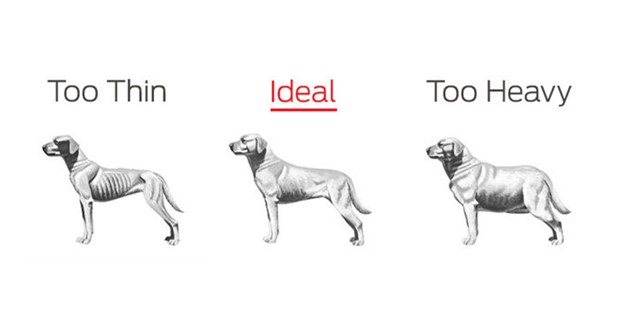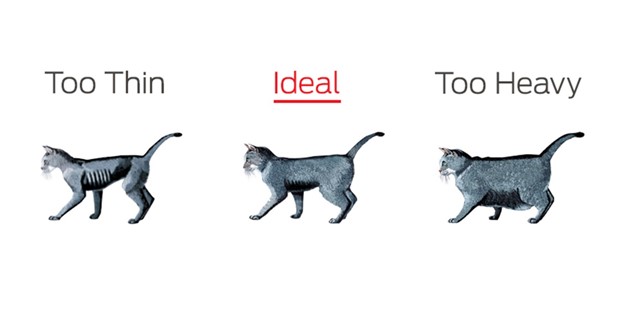
Many of the pets we see at Wags and Whiskers are overweight. Although pet parents do not feel their pets are overweight, or it’s not that much extra weight, extra weight can be a big problem for our pets. It is not unusual for pets to be overfed. What we think of as a little snack can be way too many calories for our pets. However, before making a modification to your pet’s diet, it is key to determine their body condition score.
For a dog or cat, the perfect body condition score is 5/9. Looking at your pet from above you’ll be able to see a visible waist behind the ribs. Looking at your pet from the side you will see a visible waist with a tuck up behind their rib cage. For short haired dogs the last rib may also be visible. For cats, ideally they will have a thin layer of fat covering their body and their ribs will not be visible. The ribs of a cat at ideal weight can easily be felt when you run your hand over them. If your pet does not have a visible waist from above, is more of a rectangle shape than a triangle shape, and you cannot feel its ribs, it is overweight.
Once you’ve determined if your pet is overweight, ideal or underweight the next step would be to determine their nutritional needs. To determine their nutritional needs you would need to know your pet’s current weight, your pet’s ideal weight, their breed, their age, their activity level and if they are spay or neutered. Obviously growing puppies and kittens, breeding females and working dogs have different nutritional needs than the average house pet. Different breeds of dogs have different caloric requirements because of their differences in sizes and metabolisms. Just like humans, as pets age their metabolism changes, and often they are not as active. It’s also important to note that when your pet is spayed or neutered their metabolism changes greatly. For this reason we usually recommend cutting back food by 25% when a pet is spayed or neutered. If you need guidance on how much to feed your pet, please call your veterinarian. We would be happy to help evaluate your pets current weight and any changes that need to be made.
It’s also important to realize that treats and table scraps can make a large impact on your pet’s diet. What may seem like a small snack to you may provide a significant portion of your pet’s daily calories. For example, giving one ounce of cheese to a cat, is equivalent to a human eating a whole wheel of cheese! Check out the pet calorie converter on Hill’s website https://www.hillspet.com/pet-calorie-converter Another source of calories we also often overlook are treats given to your pet for training, or cheese or pill pockets for medication. These also count toward your pet’s daily calories! If your pet is counting calories use some of their kibble from their daily meals for training, or pick a low calorie treat like green beans or ice.
It is also important to note that some pets, just like humans, may have a medical reason for being too heavy or too thin. If your pet’s weight is not ideal, and they are experiencing issues with vomiting, diarrhea, mobility, labored breathing, issues eating or drinking too much or too little they may need to be evaluated for a medical issue. Also, if you feel you are feeding your pet appropriately and they are still not in the ideal body condition then they may need to be evaluated for a medical issue.
Keeping your pet at a healthy weight can increase their quality of life and their longevity. Pets at a healthy weight are less likely to have issues with their hearts, lungs, or joints. They are also less likely to develop diabetes or other metabolic diseases. We are passionate about helping your pet live their best, fullest life at Wags and Whiskers. Please call today to set up a weight loss or nutrition consultation with Dr. Janelle.
